In this blog we’ll be exploring menu planning tips for early years settings, such as nurseries and childminders.
Did you know, the Eat Better Start Better (EBSB) guidelines (opens in new tab) are the voluntary food and drink guidelines for early years settings, here in the UK? Following EBSB will support your setting to meet the EYFS welfare requirement for the provision of healthy, balanced and nutritious food and drink.
Menu Planning Tips for Early Years Settings
Plan menus which outline all of the meals and snacks provided in your setting
- It sounds simple, but one of our key menu planning tips for early years settings, is to ensure that your menu should clearly outline what foods are offered across all meals, puddings AND snacks.
- Planning your menus over a number of weeks will help your setting to check that the foods on offer are balanced and varied.
- Planning ahead also helps you with food shopping, preparation, and stock control of the food in your setting.
- Try to plan menus lasting a number of weeks. A menu covering between two and four weeks will provide children with lots of dietary variety and keep them interested and excited about the foods on offer.
- Don’t forget that variety across your menu also ensures that children who attend your setting on the same day each week are not always provided with the same foods!
- Plan your menus so that meals, snacks and drinks meet the Eat Better Start Better Guidelines.
- If families choose to provide their child with a packed lunch to bring into your setting, encourage them to try and serve similar foods to those on offer on your menu. We’ve written a healthy packed lunch blog (opens in new tab), which may be useful to share with your families.
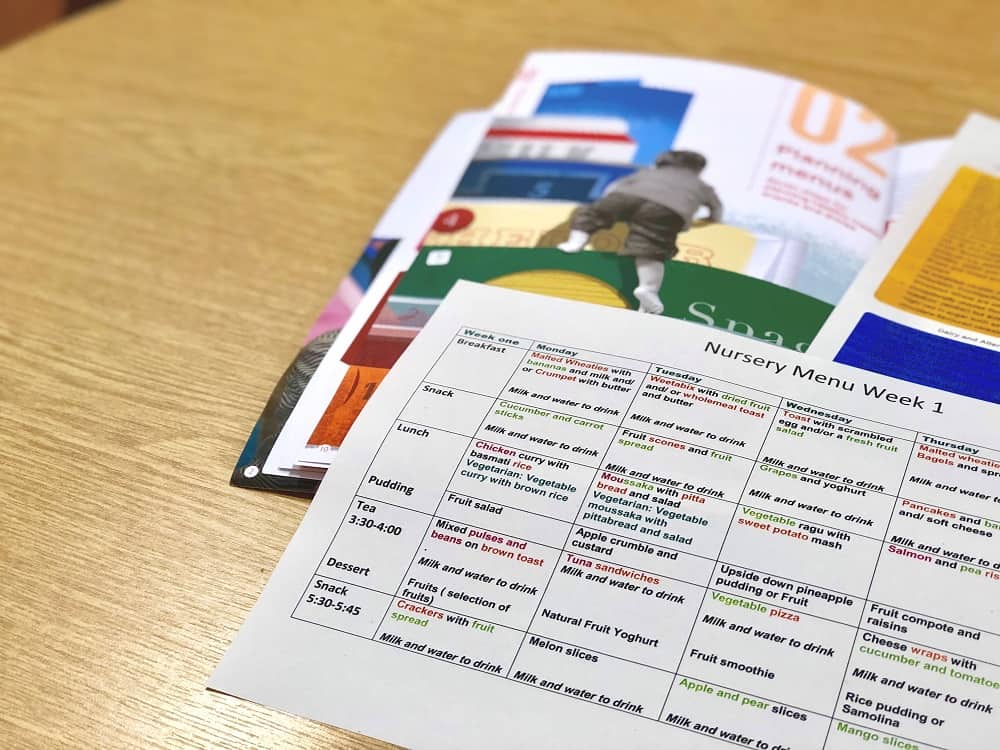
Include a variety of foods, tastes, textures and colours in your setting menus!
- Include colourful foods at meal and snacks times, to make dishes look interesting and appealing.
- For example, a meal of chicken, rice, cauliflower and a pudding of pears and a cup of milk lacks colour contrast. A meal of turmeric chicken (yellow) with peas (green) and rice (white), wholemeal chapatti (brown) with strawberries (red) and a cup of milk (white) would look much more appealing!
- Remember that meals containing too many different or new flavours may not be accepted by children, so strive for an assortment of flavours across each day, but keep individual meals relatively simple.
- Try to balance flavours – both mild (fruit, vegetables, pulses and lentils) and strong flavours (cheeses, acidic and lightly spiced foods).
Meal, pudding and snack examples
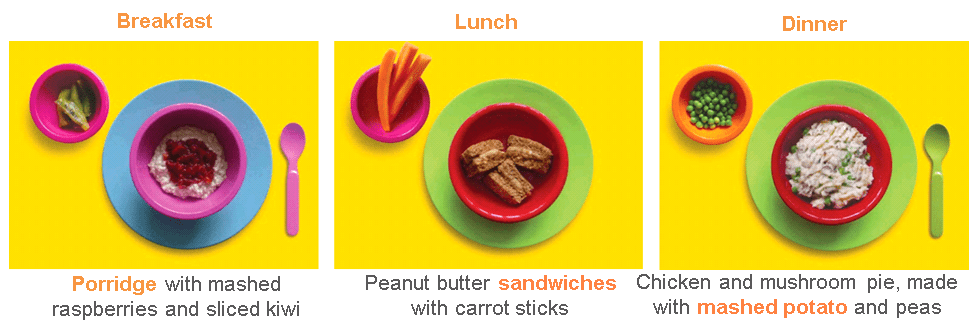
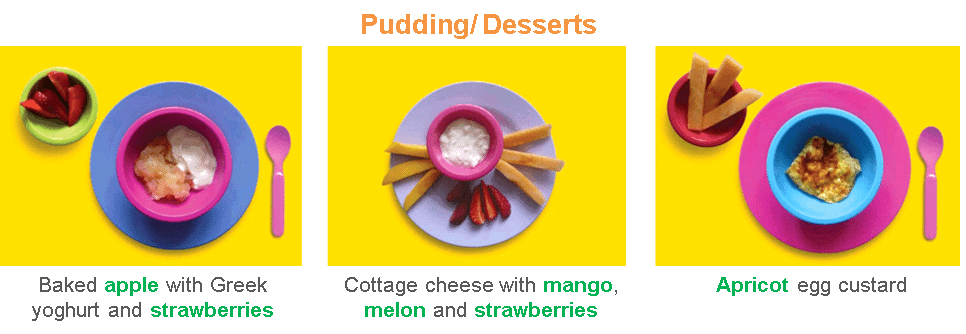

Cater for the cultural and dietary needs of all children
Whether they’re based on cultural or religious beliefs, or if they’re for medical reasons, children’s choices, beliefs and safety must be respected and protected at all times. It’s therefore important to:
- Collect dietary information from families when they register their child at your setting.
- Talk to families about how you can meet their child’s dietary needs and follow any health care professional advice that’s provided.
- Clearly communicate this information to ALL staff in the setting, so everyone is aware of children’s individual dietary requirements.
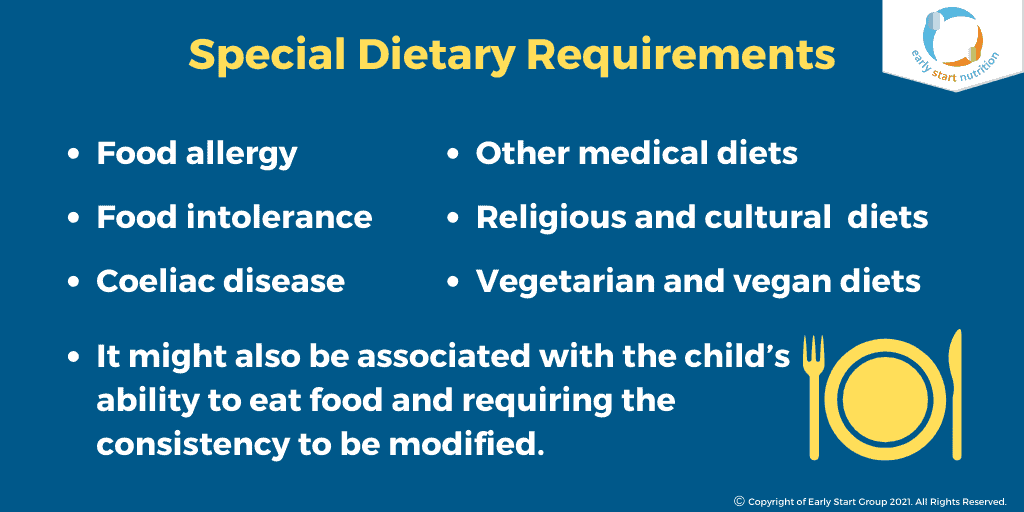
It’s essential that your setting understands what ingredients and which allergens are present in every meal and snack that’s offered. This is an important step in providing food and drink which is safe and appropriate. Your menu should offer suitable alternatives for any children with allergies or dietary restrictions.
Early Years settings are also required to provide details about the allergens present in the food they provide (check out the Food Standards Agency website for more info).
Many early years settings in England have a diverse population, with children attending from different ethnic and religious groups. So it’s essential to consider the dietary needs of all of the children attending your setting, and talk to families to make sure you cater for their child. It’s also important to introduce all children to a variety of foods so they can learn to appreciate the diets of different cultures.
Introduce new menu cycles at least twice a year
Another one of our key menu planning tips for early years settings, is to introduce new menu cycles at least twice a year. Generally, settings follow a spring/summer menu and an autumn/ winter menu. This will mean that:
- Children are exposed to new foods, tastes, and textures throughout the year.
- Staff and children’s don’t become bored of the foods on offer.
- You can incorporates seasonality into your menus and teach children about foods in season.
- Foods is more affordable and you’re setting is being environmentally responsible.
- You can plan to serve foods that you’ve grown in your setting!
Early Start Nutrition Example Menus:
- Spring/ Summer Menus (Word, 115KB)
- Autumn/ Winter Menus (Word, 105KB)
- Vegetarian Menu (Spring/ Summer) (Word, 110KB)

When it comes to planning menus, try to include everyone who is involved in the buying, cooking and serving of the food. For example, your settings chef, managers and practitioners. It’s also nice to include families and children when planning new menu cycles so you can take into account their feedback and suggestions!
Share your menus with families
It’s important that families know what food their child has been offered when they’re attending childcare. Not only is it nice to know what they’ve eaten, but it will help families to plan balanced meals and snacks at home. This ensures that children aren’t being offered the same food at home each day, as those they’ve eaten in nursery.
Include the timing of meals and snacks on your menu, so parents understand their child’s routine while in your care. They may like to try and follow a similar mealtime routine at home too.
In our experience, parents are often surprised by the range of foods on offer in their child’s setting, and may even discover that their child is eating foods that they refuse at home!
To help families to know what their child is eating:
- Display your menus somewhere that families can see them, e.g. in your reception area.
- Email families a copy of your menus at the start of a new menu cycle.
- Have discussions with families at collection and describe what foods their child has eaten.
- Invite families in to try new dishes and discuss ideas for your next menu cycles.
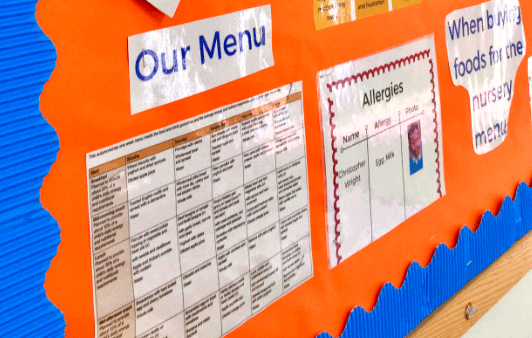
Looking to Review your Nursery Menu?
Our expert Registered Nutritionists provide comprehensive reviews to ensure your nursery menus meet the EBSB food and drink guidelines.
Find out more here on our Nursery Menu Review page (opens in new tab)
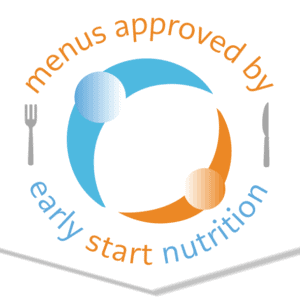
For more information and advice on planning your settings menus, sign up to our online Menu Planning training (opens in new tab) (only £36). You’ll explore:
- How to produce healthy balanced menus that meet the Eat Better, Start Better food and drink based guidelines.
- How to develop menus that cater for all special dietary requirements (including vegetarian diets, allergies, cultural and religious requirements).
- Ways to support children at mealtimes, considering the dining environment, strategies to manage fussy eating and cooking activities.
